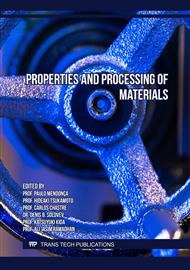[1]
M.J. Hajipour, K.M. Fromm, A. Akbar Ashkarran, D. Jimenez de Aberasturi, I.R. de Larramendi, T. Rojo, V. Serpooshan, W.J. Parak, M. Mahmoudi, Antibacterial properties of nanoparticles, Trends in Biotechnology. 30 (2012) 499–511.
DOI: 10.1016/j.tibtech.2012.06.004
Google Scholar
[2]
A.G. Kolhatkar, A.C. Jamison, D. Litvinov, R.C. Willson, T.R. Lee, Tuning the Magnetic Properties of Nanoparticles, International Journal of Molecular Sciences 2013. 14 (2013) 15977–16009.
DOI: 10.3390/ijms140815977
Google Scholar
[3]
P. Christian, F. Von der Kammer, M. Baalousha, T. Hofmann, Nanoparticles: structure, properties, preparation and behaviour in environmental media, Ecotoxicology 2008. 17 (2008) 326–343.
DOI: 10.1007/s10646-008-0213-1
Google Scholar
[4]
D. Guo, G. Xie, J. Luo, Mechanical properties of nanoparticles: basics and applications, Journal of Physics D: Applied Physics. 47 (2013) 013001.
Google Scholar
[5]
M.T. Ansari, F. Sami, F.A. Khairudiin, M.Z. Atan, T.A.S. bin Tengku Mohamad, S. Majeed, S. Ali, Applications of Zinc Nanoparticles in Medical and Healthcare Fields, Current Nanomedicine. 8 (2018) 225–233.
DOI: 10.2174/2405461503666180709100110
Google Scholar
[6]
N. Kheyri, H.A. Norouzi, H.R. Mobasser, B. Torabi, Effects of Silicon and Zinc Nanoparticles on Growth, Yield, and Biochemical Characteristics of Rice, Agronomy Journal. 111 (2019) 3084–3090.
DOI: 10.2134/agronj2019.04.0304
Google Scholar
[7]
F.E. Kruis, H. Fissan, A. Peled, Synthesis of nanoparticles in the gas phase for electronic, optical and magnetic applications—a review, Journal of Aerosol Science. 29 (1998) 511–535.
DOI: 10.1016/s0021-8502(97)10032-5
Google Scholar
[8]
U. Backman, J.K. Jokiniemi, A. Auvinen, K.E.J. Lehtinen, The Effect of Boundary Conditions on Gas-phase Synthesised Silver Nanoparticles, Journal of Nanoparticle Research. 4 (2002) 325–335.
DOI: 10.1023/a:1021148001483
Google Scholar
[9]
T. Yamamoto, M. Adachi, K. Kawabata, K. Kimura, H.W. Hahn, Palladium carbide nanoparticles by gas flow reaction synthesis, Applied Physics Letters. 63 (1998) 3020.
DOI: 10.1063/1.110245
Google Scholar


